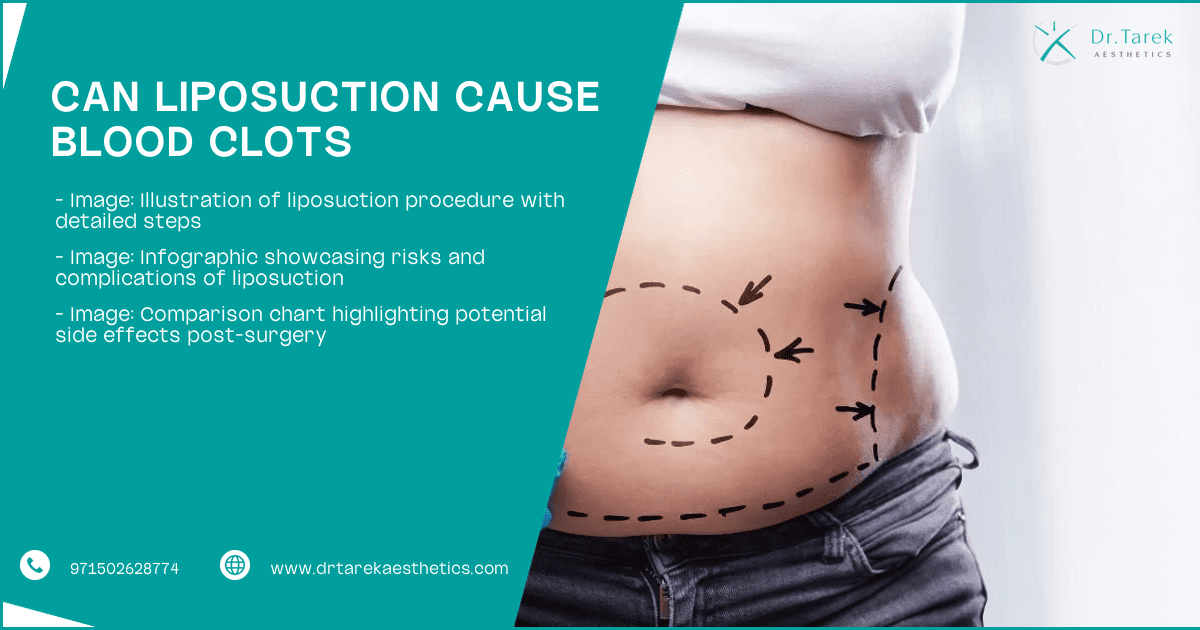How Does Liposuction Work?
Liposuction is a popular cosmetic surgery that removes excess fat from specific areas of the body. The procedure involves making small incisions through which a cannula is inserted to suction out fat deposits. While generally safe, liposuction carries certain risks, including the potential for blood clot formation.
Ensuring a Safe Liposuction Experience with Dr. Tarek Bayazid
When considering liposuction, it’s important to feel confident about your safety and the success of the procedure. Under the expert care of Dr. Tarek Bayazid, you can trust that every measure is taken to minimize risks and enhance your overall experience.
- Proactive Risk Management: Dr. Tarek Bayazid utilizes advanced surgical techniques and adheres to the highest medical standards to reduce potential complications.
- Blood Clot Prevention: Dr. Tarek Bayazid’s team diligently prevents blood clots by encouraging early movement after surgery and providing compression garments, making conditions like deep vein thrombosis (DVT) and pulmonary embolism (PE) highly unlikely.
- Infection Control: A sterile surgical environment and meticulous attention to detail significantly lower the risk of infection, promoting a smooth recovery.
- Minimal Bleeding: Careful surgical planning and precision techniques help minimize bleeding during and after the procedure.
- Anesthesia Excellence: An experienced anesthesiologist will be by your side, using the safest anesthesia practices to keep you comfortable and secure throughout the surgery.
Factors Increasing Blood Clot Risk in Liposuction
Patient Health History
A patient’s health history plays a crucial role in determining the risk of blood clots. Conditions such as obesity, smoking, and a history of clotting disorders can significantly elevate this risk. Patients need to disclose their full medical history to their surgeon.
Surgical Technique
The technique used during liposuction can also impact the likelihood of blood clot formation. Surgeons must employ meticulous methods to minimize tissue trauma and ensure proper blood flow. Advanced techniques like tumescent liposuction can reduce the risk of complications.
Book A Consultation With Dr Tarek Bayazid
Top-rated Plastic Surgeon For Liposuction in Dubai
Installment Plan Available
Post-operative Care
Proper post-operative care is vital in preventing blood clots. This includes encouraging patients to move around as soon as possible after surgery and using compression garments to promote blood circulation.
- Obesity
- Smoking
- History of clotting disorders
Symptoms of Blood Clots After Liposuction
Deep Vein Thrombosis (DVT) Signs
Deep vein thrombosis (DVT) is a condition where blood clots form in the deep veins, usually in the legs. Symptoms include swelling, pain, and redness in the affected area. If left untreated, DVT can lead to more severe complications.
Pulmonary Embolism Warning Signs
Pulmonary embolism (PE) occurs when a blood clot travels to the lungs and causes a blockage. Symptoms include sudden shortness of breath, chest pain, and coughing up blood. PE is a medical emergency that requires immediate attention.
- Swelling
- Pain
- Redness
Preventing Blood Clots During and After Liposuction
Pre-operative Screening
Pre-operative screening is essential to identify patients at high risk for blood clots. This includes a thorough medical history review and possibly blood tests to assess clotting factors. Identifying risks beforehand allows for tailored preventive measures.
Intra-operative Measures
During the surgery, surgeons can take specific measures to reduce the risk of blood clots. This includes using minimally invasive techniques and ensuring the patient is well-hydrated. Proper positioning during surgery can also help maintain blood flow.
Post-operative Care and Movement
Post-operative care is crucial in preventing blood clots. Patients are encouraged to move around as soon as possible to promote blood circulation. Compression garments and medications like anticoagulants may also be prescribed.
- A thorough medical history review
- Blood tests to assess clotting factors
- Minimally invasive techniques
Treatment Options for Blood Clots Following Liposuction
Anticoagulation Therapy
Anticoagulation therapy involves the use of medications that prevent blood clots from forming or growing. These medications, such as heparin or warfarin, are often prescribed to patients at risk of developing clots after surgery.
Thrombolysis
Thrombolysis is a treatment that involves dissolving blood clots using medication. This procedure is typically reserved for severe cases where the clot poses a significant risk to the patient’s health.
Surgical Intervention
In some cases, surgical intervention may be necessary to remove a blood clot. This is usually considered when other treatments have failed or when the clot is life-threatening.
- Heparin
- Warfarin
- Dissolving blood clots using medication
What is the likelihood of developing blood clots after liposuction
Statistical Data
According to a study published in the Aesthetic Surgery Journal, the incidence of deep vein thrombosis after liposuction is approximately 0.35%. This statistic highlights that while the risk exists, it is relatively low.
Risk Factors
Several factors can increase the likelihood of developing blood clots after liposuction. These include the patient’s age, overall health, and the extent of the surgery. Understanding these risk factors can help in taking preventive measures.
- 0.35% incidence of DVT
- Patient’s age
- Overall health
How long after liposuction can blood clots form
Immediate Post-operative Period
Blood clots can form immediately after surgery, typically within the first few days. This period is critical, and patients are closely monitored for any signs of complications.
Long-term Risk
While the immediate post-operative period is the most critical, the risk of blood clots can persist for several weeks. Patients should continue to follow their surgeon’s advice and take preventive measures during this time.
- First few days post-surgery
- Several weeks post-surgery
Can compression garments help prevent blood clots after liposuction
Benefits of Compression
Compression garments are designed to improve blood circulation and reduce the risk of blood clots. They apply gentle pressure to the treated areas, helping to prevent the formation of clots.
Proper Usage Guidelines
Compression garments must be worn correctly for them to be effective . Patients should follow their surgeon’s instructions on how long to wear the garments and how to care for them.
- Improve blood circulation
- Reduce the risk of blood clots
- Follow surgeon’s instructions
Are there any alternatives to liposuction with lower blood clot risk
Non-invasive Fat Reduction Methods
Non-invasive fat reduction methods, such as CoolSculpting and laser lipolysis, offer alternatives to traditional liposuction. These methods carry a lower risk of blood clots as they do not involve surgery.
Minimally Invasive Techniques
Minimally invasive techniques, such as ultrasound-assisted liposuction, also present a lower risk of blood clots. These methods involve smaller incisions and less tissue trauma, reducing the likelihood of complications.
- CoolSculpting
- Laser lipolysis
- Ultrasound-assisted liposuction
What should I do if I suspect a blood clot after liposuction
Immediate Actions
If you suspect a blood clot after liposuction, it is crucial to seek medical attention immediately. Early intervention can prevent serious complications and improve outcomes.
When to Seek Medical Help
You should seek medical help if you experience symptoms such as swelling, pain, or redness in the treated area. Additionally, symptoms like sudden shortness of breath or chest pain warrant immediate medical attention.
- Seek medical attention immediately
- Swelling, pain, or redness
- Sudden shortness of breath or chest pain
FAQs
Can liposuction cause blood clots?
Yes, liposuction can cause blood clots, although the risk is relatively low. Proper pre-operative screening and post-operative care can help minimize this risk.
What are the symptoms of a blood clot after liposuction?
Symptoms of a blood clot after liposuction include swelling, pain, and redness in the treated area. In severe cases, symptoms may include sudden shortness of breath and chest pain.
How can I prevent blood clots after liposuction?
Preventing blood clots after liposuction involves following your surgeon’s advice, wearing compression garments, and moving around as soon as possible after surgery. Medications like anticoagulants may also be prescribed.
What should I do if I suspect a blood clot after liposuction?
If you suspect a blood clot after liposuction, seek medical attention immediately. Early intervention can prevent serious complications and improve outcomes.
Are there alternatives to liposuction with a lower risk of blood clots?
Yes, non-invasive fat reduction methods like CoolSculpting and laser lipolysis offer alternatives to traditional liposuction with a lower risk of blood clots. Minimally invasive techniques are also available.
How long after liposuction can blood clots form?
Blood clots can form immediately after surgery, typically within the first few days. However, the risk can persist for several weeks, so it’s essential to continue following preventive measures.











Related Posts